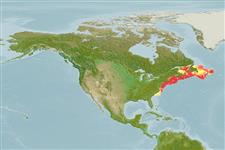Elasmobranchii (sharks and rays) >
Rajiformes (Skates and rays) >
Rajidae (Skates)
Etymology: Dipturus: Greek, di = two + Greek, pteryx = fin (Ref. 45335).
Environment / Climate / Range
Ecology
Marine; demersal; oceanodromous (Ref. 51243); depth range 0 - 750 m (Ref. 55276), usually 0 - 150 m (Ref. 55276). Temperate; ? - 20°C, preferred 9°C (Ref. 107945); 51°N - 33°N, 84°W - 42°W (Ref. 55276)
Western Atlantic: Grand Bank and southern Gulf of St. Lawrence in Canada to North Carolina, USA. Threatened with extinction by intensive trawling (Ref. 27438).
Size / Weight / Age
Maturity: Lm ? range ? - ? cm
Max length : 152 cm TL male/unsexed; (Ref. 5951); max. published weight: 18.0 kg (Ref. 7251)
Short description
Morphology | Morphometrics
Disk broad, with sharply angled corners and a pointed snout; front edges concave. No middorsal spines on disk. Tail with 3 rows of spine (1 middorsal row and 1 row on each side). Dorsal fins close together (Ref. 7251). Upper surface brownish, with many scattered small dark spots. Mucous pores on nuchal region. Lower surface white, blotched irregularly with gray (Ref. 6902).
Occur from water's edge to 430 m depth; absent from shoal waters in south during warm months (Ref. 7251). Found in salinities that range from 35 along the continental edge to 31.5 inshore along the open coast and as low as 21-24 (Ref. 6902). Live on all kinds of bottom (Ref. 205). Benthic (Ref. 5951). Feed on bivalve mollusks, squids, rock crabs, lobsters, shrimps, worms and fishes. Oviparous. Distinct pairing with embrace. Young may tend to follow large objects, such as their mother (Ref. 205). Eggs are oblong capsules with stiff pointed horns at the corners deposited in sandy or muddy flats (Ref. 205). Egg capsules are 7.1-13.2 cm long and 4.6-7.4 cm wide (Ref. 41250). Little use is made of the small quantities that are caught. In some cases, they are made into fish meal.
Life cycle and mating behavior
Maturity | Reproduction | Spawning | Eggs | Fecundity | Larvae
Oviparous, paired eggs are laid. Embryos feed solely on yolk (Ref. 50449). Distinct pairing with embrace. Young may tend to follow large objects, such as their mother (Ref. 205).
McEachran, J.D. and K.A. Dunn, 1998. Phylogenetic analysis of skates, a morphologically conservative clade of elasmobranchs (Chondrichthyes: Rajidae). Copeia 1998(2):271-290. (Ref. 27314)
IUCN Red List Status (Ref. 115185)
CITES (Ref. 94142)
Not Evaluated
Threat to humans
Harmless
Human uses
Fisheries: of no interest; gamefish: yes
More information
ReferencesAquacultureAquaculture profileStrainsGeneticsAllele frequenciesHeritabilityDiseasesProcessingMass conversion
Tools
Special reports
Download XML
Internet sources
